Environmental Screening and Evaluation of Energy-using Products (EuP) Final Report
11 Residential room conditioning appliances (aircon and ventilation) (Lot 10)
- 11.1 Background
- 11.2 Environmental screening based on the Ecoinvent database
- 11.3 Ecolabel requirements
- 11.4 Technology and market trends
- 11.5 Conclusion
11.1 Background
Although at European level the penetration of small air-conditioners is still small (about 4% of residential space), in some countries such as Italy and Spain the penetration of small air-conditioners reached in 2005 significant penetration levels similar to the US where there is a penetration of about 20%. Total residential air-conditioners’ electricity consumption in EU-25 in year 2005 was estimated to be between 7-10 TWh per year.
11.2 Environmental screening based on the Ecoinvent database
The environmental screening for Residential room conditioning appliances (aircon and ventilation) is based on the Ecoinvent processes:
- Ventilation of dwellings, decentralized, 6 x 120 m³/h, steel ducts, with GHE (Ground Heat Exchanger).
- Ventilation of dwellings, decentralized, 6 x 120 m³/h, PE ducts, with GHE
- Ventilation of dwellings, central, 1 x 720 m³/h, steel ducts, with GHE
- Ventilation of dwellings, central, 1 x 720 m³/h, PE ducts, with GHE
- Ventilation of dwellings, decentralized, 6 x 120 m³/h, steel ducts, without GHE
- Ventilation of dwellings, decentralized, 6 x 120 m³/h, PE ducts, without GHE
Some of the main assumptions for the Ecoinvent data are:
- The ventilation systems are all for multi family houses (6 flats).
- A ventilator power requirement of 0.4 Wh/m³
- A power requirement for the control system of 10 watts
- Operating time of installations over the whole years (12 months)
- The reduces thermal gain without an ground heat exchanger as well as the additional power requirement for frost protection were taken into account.
- The service lifetime of the ventilation system is assumed to be 50 years.
- The calculations are based on Swiss electricity mix.
Further details can be found in the Ecoinvent report by Hässig and Primas [Häs2007].
In this screening it is assumed that the main principles and hence the environmental profile for “single family houses” are quite similar to the “multi family ventilation systems” modelled by Ecoinvent.
However, it is not reasonable to assume that air-condition systems have the same environmental profile as ventilation systems, as the air-condition systems contain refrigerants. As there are no air-condition systems in the Ecoinvent database, the “Heat, at air-water heat pump, 10kW” process has been used as a proxy for air-conditioning. Moreover, Ecoinvent has used the refrigerant “R134a” in the modelling.
Figure 11.1 to Figure 11.6 show the screenings of the ventilation systems. It should be kept in mind that all data for ventilation systems are based on the Swiss electricity mix instead of the European electricity mix used for most other Ecoinvent processes. When using Swiss electricity mix, the electricity related emissions are considerably underestimated compared to the European electricity mix (see chapter 1). Hence, when analysing the data one should keep in mind that the environmental impacts from the electricity consumption is tremendously underestimated (but for “Non-renewable energy” and “Mineral extraction”). Bearing this in mind, it can be concluded that for ventilation systems:
- The electricity consumption during use is by far the most significant contributor to the environmental impacts from ventilation systems.
- The ventilation system and the ventilation equipment also contribute notably to the environmental impacts.
- Furthermore, the steel silencer contributes to some extent to the environmental impacts.
An analysis of the ventilation system and the ventilation equipment has been carried out and the results are shown in Figure 11.7 to Figure 11.9. From these (and from comparing analysis, not shown here) it can be seen that the steel ducts contribute more the overall environmental impacts than PE ducts. Furthermore, the main contributions from the ventilation equipment come from the zinc coating and the production of aluminium and copper.
Ecoinvent write in their conclusion (if using this anywhere please refer to the original Ecoinvent report by Hässig and Primas [Häs2007]:
“An ecologically optimised ventilation unit would have approximately the following features:
- A ventilation system with a central ventilator, an ground heat exchanger and polythene tubes run in the concrete ceiling for distributing the air in the dwelling
- A rugged ventilator with a long service life thanks to the good replaceability of its components
- Heat exchangers with a heat recovery rate of 85 to 90%
- Ventilators with low power consumption thanks to the use of optimally designed DC or EC motors (total of 0.3 watt per m³/h or less).
- An air distribution with a low pressure drop
- Tight dimensioning of air quantity and demand-oriented controlling
- Operation of the ventilation unit only during the heating period”
Figure 11.10 show the screening of the Ecoinvent process “Heat, at air-water heat pump 10kW” as an approximation for air-conditioning systems. From the figure it can be seen that the electricity consumption during use is the absolutely largest contributor to the environmental impacts. However, the heat pump it self also has significant impacts. The refrigerant, which in this case is R134a, contributes significantly to photochemical ozone formation (impacts on vegetation). An analysis of the production of R134a (not shown) demonstrates that it is mainly the consumption of trichloroethylene, tetrachloroethylene and hydrogen fluoride and emissions at the refrigerant plant that contributes to the photochemical ozone formation (impacts on vegetation). An analysis of the pump (not shown) illustrates that especially the production of copper and steel for the pump contribute to the environmental impacts.
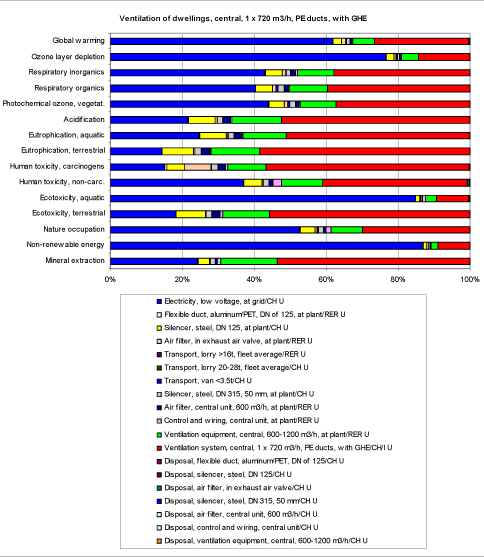
Figure 11.1 Environmental impacts from the ventilation of dwellings (central, 1 x 720 m³/h, PE ducts, with GHE)
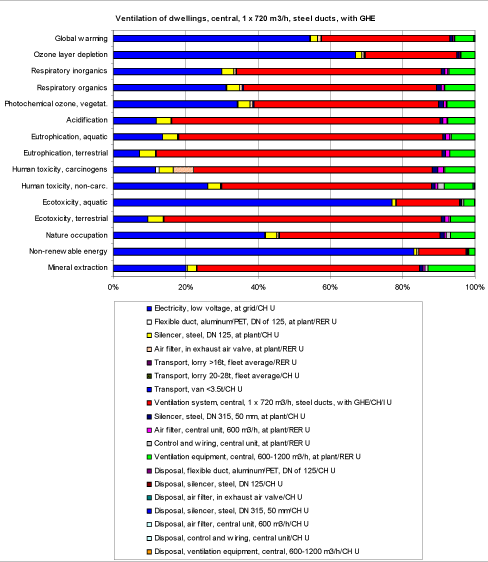
Figure 11.2 Environmental impacts from the ventilation of dwellings (central, 1 x 720 m³/h, steel ducts, with GHE).
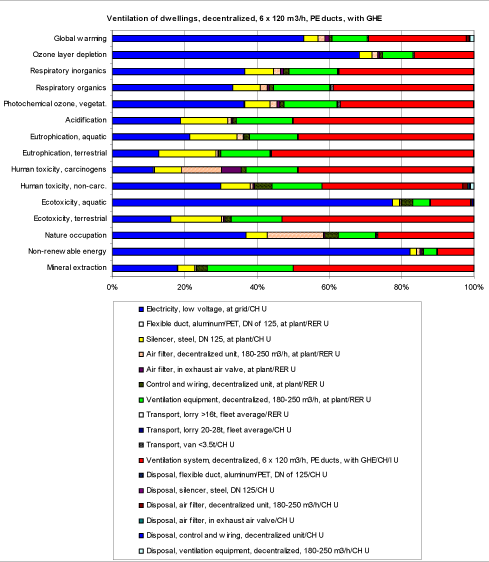
Figure 11.3 Environmental impacts from the ventilation of dwellings, decentralized, 6 x 120 m³/h, PE ducts, with GHE
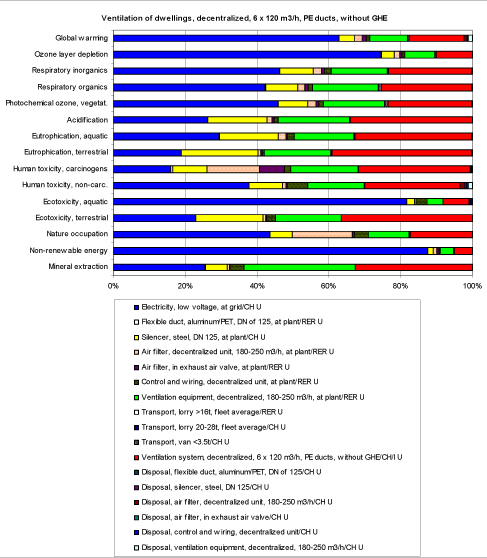
Figure 11.4 Environmental impacts from the ventilation of dwellings, decentralized, 6 x 120 m³/h, PE ducts, without GHE
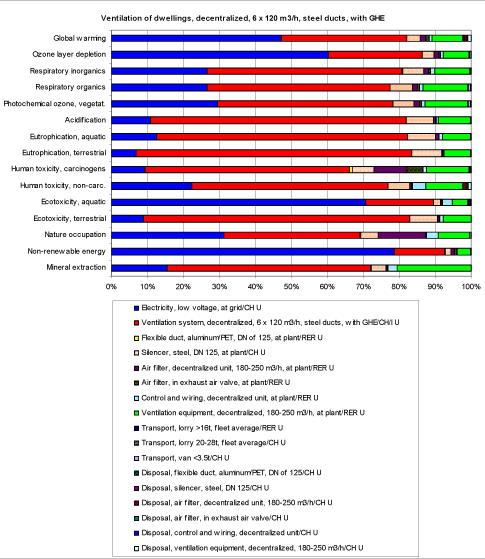
Figure 11.5 Environmental impacts from the ventilation of dwellings, decentralized, 6 x 120 m³/h, steel ducts, with GHE
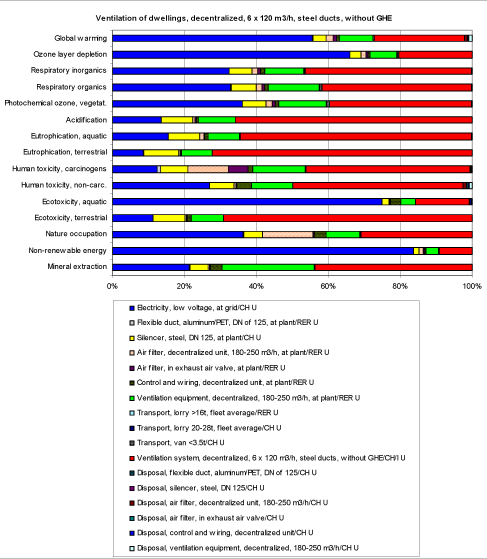
Figure 11.6 Environmental impacts from the ventilation of dwellings, decentralized, 6 x 120 m³/h, steel ducts, without GHE
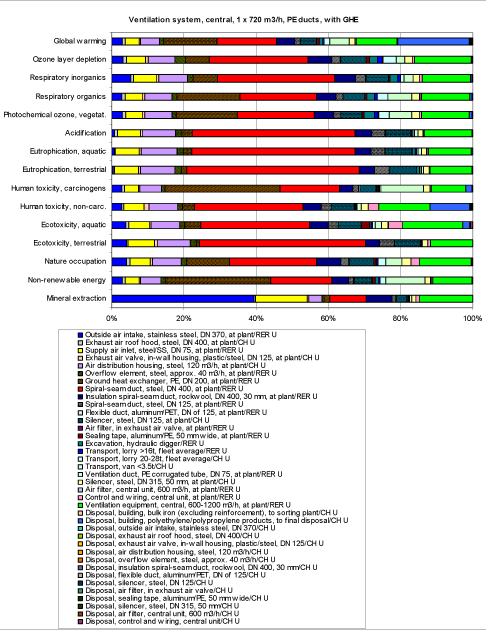
Figure 11.7 Environmental impacts from the Ventilation system, central, 1 x 720 m³/h, PE ducts, with GHE
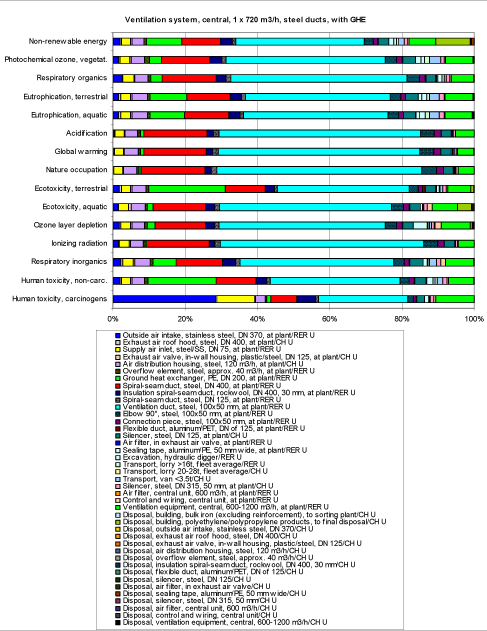
Figure 11.8 Environmental impacts from the Ventilation system, central, 1 x 720 m³/h, steel ducts, with GHE
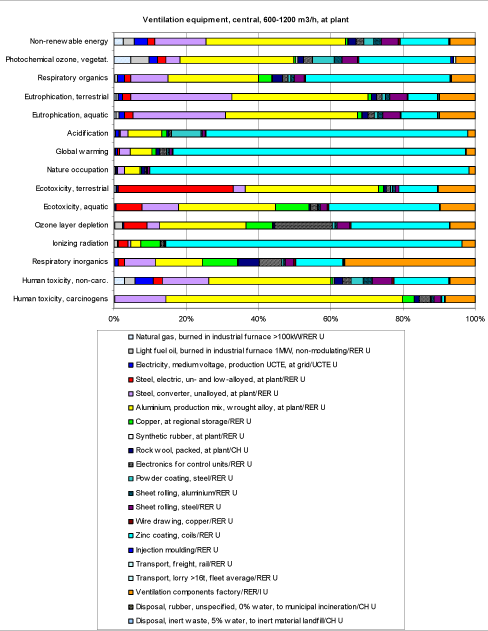
Figure 11.9 Environmental impacts from the Ventilation equipment, central, 600-1200 m³/h, at plant.
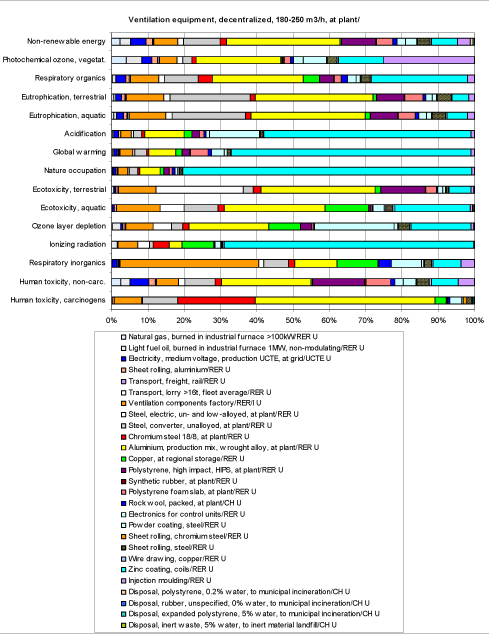
Figure 11.10 Environmental impacts from the Ventilation equipment, central, 600-1200 m³/h, at plant.
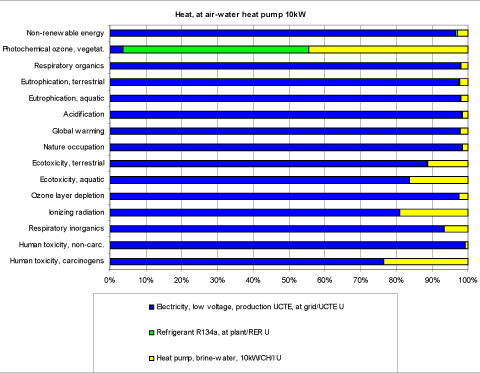
Figure 11.11 Environmental impacts from the Ecoinvent process “Heat, at air-water heat pump 10kW“.
11.3 Ecolabel requirements
For room air-conditioners (up to 12 kW output power), the Labelling Directive (2002/31/EC) has been adopted by the European Commission and was published in March 2002. [EU2002a]
The full mandatory application of this Directive was fixed for 30 June 2003. However, the relevant test standard needed to serve as the reference document was missing; the new revised standard EN 14511 covering all products in the scope of the Directive has not been finalised before May 2004. The European Commission in agreement with the Labelling Committee decided to postpone the application till just before the summer 2004. The A class limit for the split, non ducted, air-cooled air conditioners up to 12kW is set at EER[4] of 3,2; some new models have been introduced on the market with EER above 4, the best models on the market having an EER of 5,51. This indicates that the A class level is not very ambitious. In addition, there are still several E and D class models on the European market, with EER at around 2,5. [EU2002a]
Eurovent Certification certifies the performance ratings of air-conditioning and refrigeration products according to European and international standards. Eurovent certification is divided in 17 different Programmes, each of them corresponding to one type (eventually one range) of refrigeration or air-conditioning product.
11.4 Technology and market trends
Trends indicate that there continues to be an increase in demand for air-conditioning. With it comes a need for new technology. Today air-conditioning is a way of life in the U.S., Asia and Southern Europe. According to the US based Air-Conditioning and Refrigeration Institute (ARI), nearly 50% of all U.S. homes have air-conditioning and in 1996, 81% of all new homes constructed were equipped with central air-conditioning. It is generally believed that the growth will continue.
An interesting anomaly resulting from climate change is the new design conditions that are evolving for buildings as climate zones shift. Also previously inhabitable regions are being developed due to air conditioning technology. Since 1940, eight of the 10 fastest growing cities in the U.S. are located in the Southeast and Southwest parts of the country. This is the direct result of air-conditioning.
In Southern Europe (Italy, Spain, Portugal, Greece and Southern France) one of the main drivers to increases in electricity consumption and more important to electricity peak demand is the fast penetration of small residential air-conditioners (less then 12 kW output cooling power) and their extensive use during the summer months.
With rising fuel costs, it makes sense to have air-conditioning only in rooms where people are present. That could be done with motion sensors build into the Intelligent House. Georgia Institute of Technology, US have come up with a cheaper alternative by tracking small disturbances in the air flow from people opening and shutting doors. Recently, manufacturers work also to add functions to the original room temperature control function, such as air purity.
For room air-conditioners (up to 12 kW) a marked improvement of the EER can be seen in Figure 11.12. This improvement is attributed to the technological development, mainly in Japan, where there are very ambitious energy efficiency targets. The publication of the EER and the energy label in the Eurovent Certification Scheme[5] has also contributed to the increase in EER of marketable products. EER values exceeding 20 is now theoretically possible by increasing in efficiency of the compressor, the heat exchanger, and the ventilator.
Eurovent-Cecomaf has self-committed to withdraw from the market the models in G class. Implementation of this started in January 2004 with the elimination of Class G products. [Sah2006]
Researchers at Pacific Northwest National Laboratory are demonstrating lightweight and man-portable cooling technology, which potentially could lead to wearable air conditioners. The principles of micro technology and the very high rates of heat and mass transfer at this miniature scale have enabled man-portable cooling systems weighting about two kilos. Instead of using electricity to power a mechanical compressor, heat from burning fuel is used to power the cooling, thereby replacing bulky, heavy batteries with much lighter fuels. [Piq2004]
Staying cool without lowering the air conditioner thermostat may come in the form of air-conditioned clothing, an idea that was unveiled by Kuchofuku Inc. and first went into full-fledged production in April 2005. Air-conditioned clothes have two small fans about 10 centimetres in diameter attached to the right and left sides of the back of the clothing, just above the waist. The fans draw in a large amount of air and help to vaporize sweat. As the perspiration evaporates, heat is dissipated, bringing down the wearer's body temperature.
11.5 Conclusion
The electricity consumption during use is by far the most significant contributor to the environmental impacts from ventilation systems.
11.5.1 Environmental impact in a system and life-cycle perspective
The production and construction of the ventilation system itself also contribute notably to the environmental impacts. Furthermore, the steel silencer contributes to some extent to the environmental impacts. Their contributions mainly come from the energy consumption for the production and the extraction of resources for the ventilation systems.
For extraction of resources, especially extraction of nickel, aluminium, copper, iron, tin and chromium is of importance. The extraction of zinc, copper, aluminium and iron also gives significant contributions to human toxicity and eco-toxicity.
Some of the refrigerants contribute to the global warming (HFC and PFC). Some refrigerants might also have other environmental impacts, like toxicity.
11.5.2 Environmental perspective from new technologies
Hässig and Primas concludes in their original Ecoinvent report: [Häs2007]
“An ecologically optimised ventilation unit would have approximately the following features:
- A ventilation system with a central ventilator, an ground heat exchanger and polythene tubes run in the concrete ceiling for distributing the air in the dwelling
- A rugged ventilator with a long service life thanks to the good replaceability of its components
- Heat exchangers with a heat recovery rate of 85 to 90%
- Ventilators with low power consumption thanks to the use of optimally designed DC or EC motors (total of 0.3 watt per m³/h or less).
- An air distribution with a low pressure drop
- Tight dimensioning of air quantity and demand-oriented controlling
- Operation of the ventilation unit only during the heating period”
In line with the paradigm of “Central production – local control”, the authors tends to favour solutions based on large, central units (e.g. for apartment blocks) incorporating environmental clean and renewable energy sources.
[4] EER = Energy Efficiency Ratio. This is the ratio between the output cooling (thermal) power and the input electrical power in the cooling mode. The EER is used to define the energy classes for the energy labelling. For reversible air-conditioners (working as heat pump) the efficiency indicator is the COP (coefficient of performance) which is defined as the EER during the heating mode.
[5] available at: www.eurovent-certification.com
Version 1.0 December 2009, © Danish Environmental Protection Agency